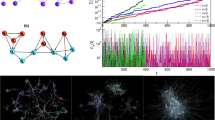Abstract
The theory of cellular automata is applied to describe the self-assembly of inorganic structures on molecular and nanoscale levels based on the example of uranyl selenates. The automaton that reproduces the structural topologies observed in these compounds is constructed, and its properties are studied. It is shown that the growth of complicated structural complexes in inorganic compounds depends on the structure of the nucleus as the initial condition of automaton’s work and, despite the topological differences of the resulting structures, the mechanisms of local interactions in these systems are identical. Under some conditions, this unity of mechanism leads to the formation of disordered structures.
Similar content being viewed by others
References
Krivovichev, S.V., Actinyl Compounds with Hexavalent Elements (S, Cr, Se, Mo)—Structural Diversity, Nanoscale Chemistry, and Cellular Automata Modeling, Eur. J. Inorg. Chem., 2010, vol. 2010, pp. 2594–2603.
Krivovichev, S.V., Kahlenberg, V., Kaindl, R., and Mersdorf, E., Self-Assembly of Protonated 1,12-Dodecanediamine Molecules and Strongly Undulated Uranyl Selenate Sheets in the Structure of Amine-Templated Uranyl Selenate: (H3O)2[C12H30N2]3[(UO2)4(SeO4)8](H2O)5, Eur. J. Inorg. Chem., 2005, vol. 2005, pp. 1653–1656.
Krivovichev, S.V., Tananaev, I.G., Kalenberg, V., and Myasoedov, B.F., Synthesis and Crystal Structure of the First Uranyl Selenite(IV)-Selenate(VI) [C5H14N][(UO2)(SeO4)(SeO2OH)], Dokl. Phys. Chem., 2005, vol. 403,part 1, pp. 124–127.
Krivovichev, S.V., Gurzhii, V.V., Tananaev, I.G., and Myasoedov, B.F., Topology of Inorganic Complexes as a Function of Amine Molecular Structure in Layered Uranyl Selenates, Dokl. Phys. Chem., 2006, vol. 409, part 2, pp. 228–232.
Ling, J., Sigmon, G.E., and Burns, P.C., Syntheses, Structures, Characterizations, and Charge-Density Matching of Novel Amino-Templated Uranyl Selenates, J. Solid State Chem., 2009, vol. 182, pp. 402–408.
Krivovichev, S.V., Gurzhiy, V.V., Tananaev, I.G., and Myasoedov, B.F., Amine-Templated Uranyl Selenates with Chiral [(UO2)2(SeO4)3(H2O)]2-Layers: Topology, Isomerism, Structural Relationships, Z. Kristallogr., 2009, vol. 224, pp. 316–324.
Ling, J., Sigmon, G.E., Ward, M., Roback, N., and Burns, P.C., Syntheses, Structures, and IR Spectroscopic Characterization of New Uranyl Sulfate/Selenate 1D-Chain, 2D-Sheet, and 3D-Framework, Z. Kristallogr., 2010, vol. 225, pp. 230–239.
Krivovichev, S.V., Kahlenberg, V., Kaindl, R., Mersdorf, E., Tananaev, I.G., and Myasoedov, B.F., Nanoscale Tubules in Uranyl Selenates, Angew. Chem., Int. Ed. Engl., 2005, vol. 44, pp. 1134–1136.
Krivovichev, S.V., Kahlenberg, V., Tananaev, I.G., Kaindl, R., Mersdorf, E., and Myasoedov, B.F., Highly Porous Uranyl Selenate Nanotubules, J. Am. Chem. Soc., 2005, vol. 127, pp. 1072–1073.
Krivovichev, S.V., Tananaev, I.G., Kalenberg, V., Kaindl’, R., and Myasoedov, B.F., Synthesis, Structure, and Properties of Inorganic Nanotubes Based on Uranyl Selenates, Radiochemistry (Moscow), 2005, vol. 47, no. 6, pp. 525–536.
Toffoli, T. and Margolus, N., Cellular Automata Machines, Boston (Massachusetts, United States): Massachusetts Institute of Technology, 1987. Translated under the title Mashiny kletochnykh avtomatov, Moscow: Mir, 1991.
Ilachinski, A., Cellular Automata: A Discrete Universe, Singapore: World Scientific, 2001.
Wolfram, S., A New Kind of Science, Urbana (Illinois, United States): Wolfram Media, 2002.
Krivovichev, S.V., Structural Crystallography of Inorganic Oxysalts, Oxford (United Kingdom): Oxford University Press, 2008.
Krivovichev, S.V., Gurzhii, V.V., Tananaev, I.G., and Myasoedov, B.F., Microscopic Model of Crystallogenesis from Aqueous Solutions of Uranyl Selenate, Zap. Ross. Mineral. O-va, 2007, vol. 136, no. 7, pp. 91–114.
Sutner, K., De Bruijn Graphs and Linear Cellular Automata, Complex Syst., 1991, vol. 5, pp. 19–30.
Author information
Authors and Affiliations
Corresponding author
Additional information
Original Russian Text © V.Ya. Shevchenko, S.V. Krivovichev, I.G. Tananaev, B.F. Myasoedov, 2013, published in Fizika i Khimiya Stekla.
Rights and permissions
About this article
Cite this article
Shevchenko, V.Y., Krivovichev, S.V., Tananaev, I.G. et al. Cellular automata as models of inorganic structures self-assembly (Illustrated by uranyl selenate). Glass Phys Chem 39, 1–10 (2013). https://doi.org/10.1134/S1087659613010100
Received:
Published:
Issue Date:
DOI: https://doi.org/10.1134/S1087659613010100




